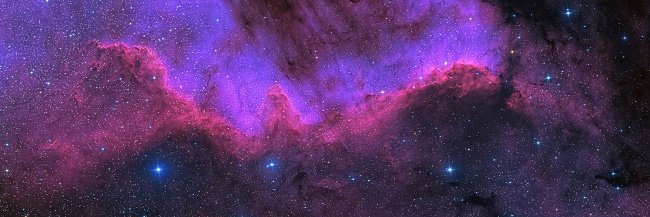Passing of Pop Star Prince Gets Purple Nebula Pic Honor!
 Cygnus Wall NGC7000 by Ken Crawford
Cygnus Wall NGC7000 by Ken Crawford
NASA paid their respects to the passing of pop star sensation, Prince, last week by tweeted a photo of the Crab Nebula. The stunning colors of purple made his fans smile and remember his flamboyant antics and signature color.
Prince died at 57 years-old in an elevator in his Paisley Park estate in Minnesota. Although, the exact cause of death is still unknown, some speculate it could be the effects of an earlier drug overdose along with added complications of an unresolved flu he had been battling.
Fans have gathered in tribute to the beloved singer with purple boxes, while NASA sent out images of the stunning Crab Nebula in tribute to the best-selling musician along with this statement;
“A purple nebula, in honor of prince, who passed away today.”
The message received tens of thousands of retweets, becoming probably the most shared of the tributes paid to the singer after his death.
ESA/Herschel/PACS/MESS Key Programme Supernova Remnant Team; NASA, ESA and Allison Loll/Jeff Hester (Arizona State University), Public domain, via Wikimedia Commons
The Crab Nebula
The passing of a star is always a time of mourning for his fan base; however, the tribute nebula is still a wondrous and majestic site to behold. Thanks to NASA this image of the Crab Nebula was made up by combining images from the Hubble Space Telescope and the European Space Agency’s Herschel Space Observatory.
The Crab Nebula was discovered in 1721 by a British astronomer by the name of, John Bevis. But research has since showed us that this nebula has been in existence since 1054 and was most likely witnessed by far-eastern astronomers as (at first) a bright spot in the evening and daytime sky for several weeks.
Fast Facts About the Crab Nebula
- Found in the constellation of Taurus, the Crab Nebula is located about 6,500 light-years from Earth
- The Crab Nebula was created when a star exploded at the end of its life cycle
- The dead star still remains at the heart of the Crab. It is now called a pulsar
- The pulsar is very dense and emits extremely high levels of radiation
- The Crab Nebula’s pulsar is thought to be 18 miles (30 km) in diameter with at least 1.5 times the mass of the sun.
- This Nebula has a span of 11 light-years across and is growing at a rate of around 1 billion kilometers each day!
- The Crab Nebula produces 75,000 times the energy of our Sun
Want to read more about Nebulae? Check out ‘A Cosmic Butterfly Named the Twin Jet Nebula.’ It’s so fascinating!
